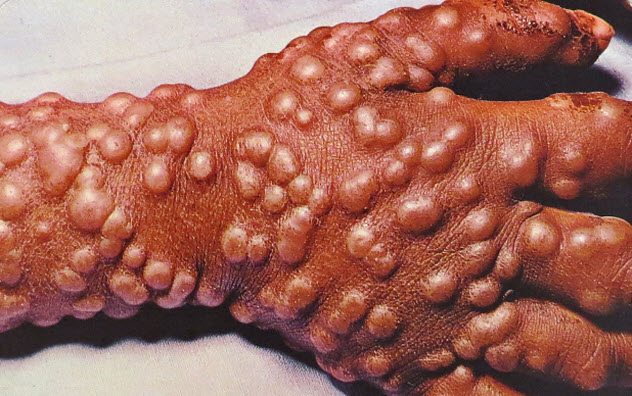 Weird Stuff
Weird Stuff  Weird Stuff
Weird Stuff  History
History 10 Times Trickery Won Battles
 Technology
Technology 10 Awesome Upgrades to Common Household Items
 Misconceptions
Misconceptions 10 Hilarious (and Totally Wrong) Misconceptions About Childbirth
 Weird Stuff
Weird Stuff 10 Warning Labels That Exist Because Someone Actually Tried It
 Health
Health Ten Confounding New Inventions from the World of Biomedicine
 Creepy
Creepy 10 Death Superstitions That Will Give You the Creeps
 Movies and TV
Movies and TV 10 Movies That Get Elite Jobs Right, According to Experts
 Weird Stuff
Weird Stuff 10 Times Real Laws Were Based on Bizarre Hypotheticals
 Animals
Animals 10 Inspiring Tales of Horses Being Human
 Weird Stuff
Weird Stuff 10 Typos That Accidentally Changed History
 History
History 10 Times Trickery Won Battles
 Technology
Technology 10 Awesome Upgrades to Common Household Items
Who's Behind Listverse?

Jamie Frater
Head Editor
Jamie founded Listverse due to an insatiable desire to share fascinating, obscure, and bizarre facts. He has been a guest speaker on numerous national radio and television stations and is a five time published author.
More About Us Misconceptions
Misconceptions 10 Hilarious (and Totally Wrong) Misconceptions About Childbirth
 Weird Stuff
Weird Stuff 10 Warning Labels That Exist Because Someone Actually Tried It
 Health
Health Ten Confounding New Inventions from the World of Biomedicine
 Creepy
Creepy 10 Death Superstitions That Will Give You the Creeps
 Movies and TV
Movies and TV 10 Movies That Get Elite Jobs Right, According to Experts
 Weird Stuff
Weird Stuff 10 Times Real Laws Were Based on Bizarre Hypotheticals
 Animals
Animals 10 Inspiring Tales of Horses Being Human
10 Infectious Diseases That Changed History
Along with natural disasters, infectious diseases are among the top unintentional causes of human death and suffering the world over. Some diseases have left their mark on the human race, warping the course of human history in their wake.
In certain cases, like that of the bubonic plague, population levels were drastically reduced for centuries afterward. In other cases, such as polio, the infection of a renowned individual led to the further recognition of a disease and the need for a cure.
10 Bubonic Plague

The bubonic plague (aka the “Black Death“) spread across Europe from east to west during the 14th century. The Yersinia pestis bacterium was responsible for the epidemic and used Oriental rat fleas as its intermediary in reaching the human population. Rats, which carried infected fleas, traveled west on the Silk Road and on ships across the Mediterranean.
The bubonic plague demonstrated early on how human advancements in commerce and trade could fatally spread a pathogen. The plague’s name comes from the Latin word bubo, referring to a pustule or abscess.
The symptoms were gruesome. They started with fever and sweating but progressed to blackish-blue boils across the groin. If the boils weren’t lanced, they grew and people would die from the toxic buildup. Likewise, lancing the buboes was often just as deadly and could lead to the pathogen becoming airborne.
The mortality rate with this disease was upward of 70 percent, killing up to 200 million across Europe and cutting the continent’s population in half.[1] Historians believe that the spread of the bubonic plague contributed to the fall of the feudal economic system and caused irreparable damage to the church.
Many priests were infected after performing last rites and funeral services. Still more withdrew from their parishes, afraid of contracting the plague. To this day, the bubonic plague ranks among history’s most gruesome diseases even as the development of antibiotics has limited the Black Death’s contemporary occurrences.
9 Smallpox

When Europeans first arrived in the New World during the late 15th and early 16th centuries, they used advanced military techniques to conquer North and South America with haste. But they also brought smallpox, which played an instrumental role in killing Native Americans.
Europeans from the Old World had a long history of living in close quarters with domesticated animals as well as eating and drinking from similar sources. This led to the spread of many diseases. But those who survived developed an impressive immunity to otherwise deadly pathogens. These individuals were among America’s first settlers, who brought smallpox to the continents as early as 1520.
In conjunction with other Old World diseases like the flu and measles, smallpox went on to kill almost 90 percent of the Native American population, far outpacing the damage done by late medieval warfare. Smallpox was also a vicious deforming agent, leaving those infected with noticeable sores across their bodies.[2]
Fast-forward several centuries, and smallpox is one of just two diseases (the other is rinderpest) to be fully eradicated from the human population due to vaccination efforts. Today, smallpox can only be found in exceedingly guarded laboratory settings.
8 Spanish Influenza

The 1918 flu pandemic was caused by one of the deadliest 20th-century pathogens, infecting 500 million individuals worldwide. Outbreaks in the United States and Europe soon spread around the world.
Although this deadly strain of the flu ravaged population centers indiscriminately, it quickly gained the moniker “Spanish influenza” as Spain was hit particularly hard by the bug. Even Spain’s King Alfonso XIII contracted it.
SSpanish influenza had a noticeable effect on World War I’s battlefields as it infected many young, otherwise healthy individuals. Records from the time suggest that more Americans were killed by the 1918 flu than from fighting on the front lines.
Forty percent of servicemen in the US Navy contracted the flu. Almost as many in the US Army were afflicted as well. The flu’s effects were noted across the economy and military, with many believing that the outbreak influenced the direction of World War I by infecting militias and destroying medical infrastructure.[3]
Flu vaccines were first developed in the 1940s.
7 Polio

Today, polio is exceedingly rare, with relatively few cases in the industrialized world since Jonas Salk developed a polio vaccine. Prior to the creation of a vaccine, polio was easily transmitted in an infected individual’s stool or via droplets when he sneezed.
Polio is commonly asymptomatic. Yet when symptoms do present themselves, they can be debilitating. The disease is notorious for paralyzing its victims, requiring them to live the rest of their lives in iron lungs. Paralysis caused by polio can’t be reversed. Although mobile generators can aid some of the afflicted, others still rely on the iron lungs made famous in the 1940s.[4]
The best-known individual to suffer polio paralysis was former US President Franklin D. Roosevelt. His efforts to combat the stigma of the disease touched every aspect of the presidency in the years leading up to and through World War II. Ultimately, this changed how a man—and a nation—viewed paralysis-inducing disease and subsequent disability.
6 Syphilis

There are four stages of syphilis, a sexually transmitted disease that first appears with a benign chancre at the spot of infection. Secondary syphilis presents with a widespread rash and swollen lymph nodes. The bacteria then enters a latent stage before surfacing as tertiary syphilis, which leads to neuromuscular degeneration, blindness, and dementia.
Historians are unsure as to how syphilis got a footing in European populations, but the leading hypothesis says that it was an import from New World colonization. Syphilis has marred many famous individuals, including several members of the medieval papacy. In 1508, Julius II was unable to have his foot kissed by fellow Christians because it was covered in syphilitic sores.[5]
Syphilis also had a long history of inspiring worthless medical remedies such as the use of mercury, which often left the infected worse off. Today, syphilis is still widespread, though it can often be cured with penicillin.
5 HIV/AIDS

Few diseases have carried the stigma of human immunodeficiency virus (HIV), which transforms into acquired immunodeficiency syndrome (AIDS). Scientists believe that the virus crossed over from primates to humans in Africa during the early 20th century. Yet the disease didn’t gain traction in popular culture until the early 1980s when several gay men in New York and California exhibited strange cases of pneumonia and cancer.[6]
Its initial association with gay men led to the early name “gay-related immune deficiency” (GRID). Paranoia swept Europe and the United States as individuals were unsure what modes were responsible for spreading the disease. HIV’s association with the gay community led to the development of activist groups like ACT UP, helping to propel early LGBT advocacy and solidify eventual rights for sexual minorities decades later.
4 Tuberculosis
 Tuberculosis (TB) is a deadly respiratory infection that can take two forms: latent TB and active TB. Latent TB isn’t contagious, and one’s immune system can often fight it off. In fact, one-third of the world’s population has latent TB.
Tuberculosis (TB) is a deadly respiratory infection that can take two forms: latent TB and active TB. Latent TB isn’t contagious, and one’s immune system can often fight it off. In fact, one-third of the world’s population has latent TB.
In weakened immune systems, active TB can take hold. Symptoms include bouts of coughing, severe chest pain, night sweats, and loss of appetite. The rise of HIV/AIDS is linked to a rise in TB cases as weakened immune systems have a nearly impossible time fighting off the otherwise latent bacteria.
Tuberculosis left its mark on science in more than one way. In the 19th century, TB was often spread through milk. This led to the development of batch pasteurization, a low-temperature method of pasteurization which has its roots in eradicating tuberculosis in dairy products.[7]
3 Malaria
 Malaria is a mosquito-borne disease caused by parasites that leave those infected with flu-like symptoms. Malaria remains one of the world’s most serious killers, infecting more than 200 million in 2016 and killing almost 500,000.
Malaria is a mosquito-borne disease caused by parasites that leave those infected with flu-like symptoms. Malaria remains one of the world’s most serious killers, infecting more than 200 million in 2016 and killing almost 500,000.
Malaria’s common claim to fame is its possible role in killing Alexander the Great. But did you know that malaria—and resistance to it—lent a hand in the brutal transatlantic slave trade? There is no evidence of malaria in precolonial America, and thus its introduction ravaged native populations.
This led early European populations to look to the people of Africa, who were resistant to malaria if they survived the disease as children, to work on America’s Southern plantations. As malaria spread like wildfire across the American South, killing off Native Americans, Africans were forced into the slave trade.[8]
On the medical side, malaria provided scientists with a fundamental understanding of transmission vectors, including how disease-carrying animals can infect human populations and what can be done to stop them.
2 Ebola

Few diseases have fueled hysteria quite like Ebola, which was only discovered in Africa in the late 1970s. Ebola, short for Ebola hemorrhagic fever (EHF), is a virus that leads to extreme bleeding in humans and other primates. Symptoms can take several days to weeks to develop. They include sore throat, muscular pain, vomiting, diarrhea, and eventual internal and external bleeding.
Depending on the strain, Ebola comes with a high mortality rate, killing almost half of those it infects. However, mortality rates can run as high as 90 percent. The deadliest Ebola outbreak spread out of West Africa in March 2014. It killed five times more individuals than all previous outbreaks combined.
Cases were reported in the United States and Europe (including the United Kingdom, France, Germany, and Spain). Full containment of the virus didn’t occur until 2016. Its spread and aftermath dramatically tested the World Health Organization’s ability to respond to a modern pandemic.[9]
1 Cholera

At its worst, cholera can go from asymptomatic to fatal in just under three hours. Cholera is a diarrheal disease caused by a bacterium that is usually spread through water or food systems that lack proper sanitation. Although the roots of the disease were in the Ganges Delta in India, cholera has since spread across the planet. There have been pandemics in South Asia (1961), Africa (1971), and the Americas (1991).
Every year, there are as many as four million cases of cholera with more than 100,000 dying as a result.[10] As of July 28, 2010, the United Nations resolved to explicitly recognize clean drinking water as a human right, a development inherently tied to the spread of water-borne bacteria.
Evan Beck is a freelance writer living in the San Francisco Bay area.
To read more about terrifying diseases, check out Top 10 Scary Ways Deadly Ailments And Diseases Are Evolving and 10 Horrifying Diseases You Definitely Don’t Want To Catch.








